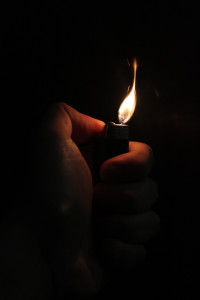Ask Cavers: Do you Test for Foul Air?

An open flame can be used to test oxygen levels. Photo by Rodrigo_Amorim/flickr
Although caves that have foul air, either due to lack of oxygen or an excess of other dangerous gasses, are a small minority, they can pose a significant risk to cavers who visit them.
How do you ensure that a cave you’re visiting is safe? Do you test the air in a cave yourself, or do you trust the reports/lack of reports from other cavers who’ve visited the cave before?
Maybe even more important, do you know the symptoms of someone breathing bad air?
Let us know in the comments below.


Comments (7)
We test for bad air (high CO2 levels) at a set of caves known to have seasonal bad air. Other than that, no. However, having experienced nominally bad air in these caves, I have recognized the symptoms in one other cave and was able to retreat before it became serious.
We check for bad air but mostly due to the fact we are exploring old mine workings with alot of rotting wood and rusting metal eating up the o2 in the blind drives
In Costa Rica, from 1968 to 2012, we’ve encountered ?Bad Air’ in ‘at least’ 4 occasions, 4 different places.
1- Bad air forms ‘pockets’ that move throughout the cave. 2- If using carbide lamps, detection is simple: flame will go dark yellow/dark red, diminish in size & produce lots of carbon particles. Then it’ll go off!!! 3- Difficulty in breathing, exhaustion, tiredness and sleepiness / somnolence are the initial symptoms. 4- Extinguish all oxygen consuming artifacts and… IMMEDIATE EVACUATION IS MANDATORY!!! – (NSS29373).
No – The only time I have experienced bad air in a cave was once 20 years or so ago when my brother Ted took me to see a known bad air cave in Central California. He was a member of the “Foul Air Research Team”(FART) at that time and was heading up to take a air sample.
I had a good carbide lamp and a new charge of carbide in it. I was running a 2-1/2″ flame – lots of light – when the light out-put suddenly diminished to deep twilight! I shook the lamp. Nothing changed…but it should have with a new carbide charge. Then I took my lamp off my head – and saw a a dark, smoky, reddish black flame that had a 1/2” gap at the gas jet!
I felt no symptoms. We left shortly.
My brother climbed out of the room first. I started up next – but my carbide lamp went out. I tried re-lighting it multiple times. Nothing. There were “no sparks” coming off of the new flint striker!
Total, total darkness.
Bruce “CaveAir” Zerr
We usually stay away from caves with known “bad air” on Mendip – its a seasonal thing – good air in Autumn/Winter, rising bad air in high summer.
Mind you I do occasionally dip into the odd mine here or there, sometimes it can get a bit “huffy puffy”, although I DO remember one mine trip where we took a 4 gas detector with us (not mine) and when we downloaded the data – it showed a mahoosive CO spike, mind you there were about 4 cigarettes on the go at that point (we were waiting for the last abseil down the ore shute, – DON’T worry the mine has a very good airflow at that particular point, its only about 20 yards to the end of the level, pity about the locked gate though!!)
We are careful only in caves with a lot of guano … or with a lot of garbage … or in mines…or in caves in areas with volcanoes
In these cases, we give an extremely care to the smell of the air, we are moving very slowly – to feel the changes in how we feel, we walk at a distance from one another – we watch the guy in front of us, if he is well….
In the other cases, especially when we are in caves with running water, we feel perfectlly safe.
Thank you.
Giannis Zavitsanakis – Archaeologist / Speleologist
West Greece – South Europe
https://www.facebook.com/GiannesZabitsanakesSpelaiologia?fref=ts
cavemania.blogspot.gr
Just two weeks ago, three of us made a trip to push a significant stream cave here in NW Arkansas, on the way in [a sleazy muddy crawl] I found myself hyperventilating just to breath, a ‘bic’ test revealed hight CO2 but I suspect that our splashing through stagnant pools was releasing extra gas from the mud and whenever we were in non muddy areas it wasn’t bad. The main reason being that both the upstream and downstream portions of the main passage were sumped this summer and the lack of air flow caused the build-up to stay. We ‘fogged’ the cave so badly that taking photos was difficult.
Comment